6IM997 Independent Study: Gender Pay Gaps in UK Accounting Firms
VerifiedAdded on 2023/04/20
|54
|13484
|115
Thesis and Dissertation
AI Summary
This thesis investigates the gender pay gap within the top four accounting firms in the UK (Deloitte, PwC, Ernst & Young, and KPMG) over the past decade (2008-2018). It explores the persistence of wage disparities between men and women, analyzes trends in the gender pay gap, and identifies factors contributing to its existence. The study employs both quantitative and qualitative analysis, including surveys and interviews with professionals in the UK financial sector, to assess the impact of pay gaps on workforce performance and the accounting job market. The research also considers the role of government intervention in addressing gender pay inequality and offers recommendations for accounting firms to promote gender equality and attract more women to the industry, such as flexible working hours and gender-neutral promotion initiatives.
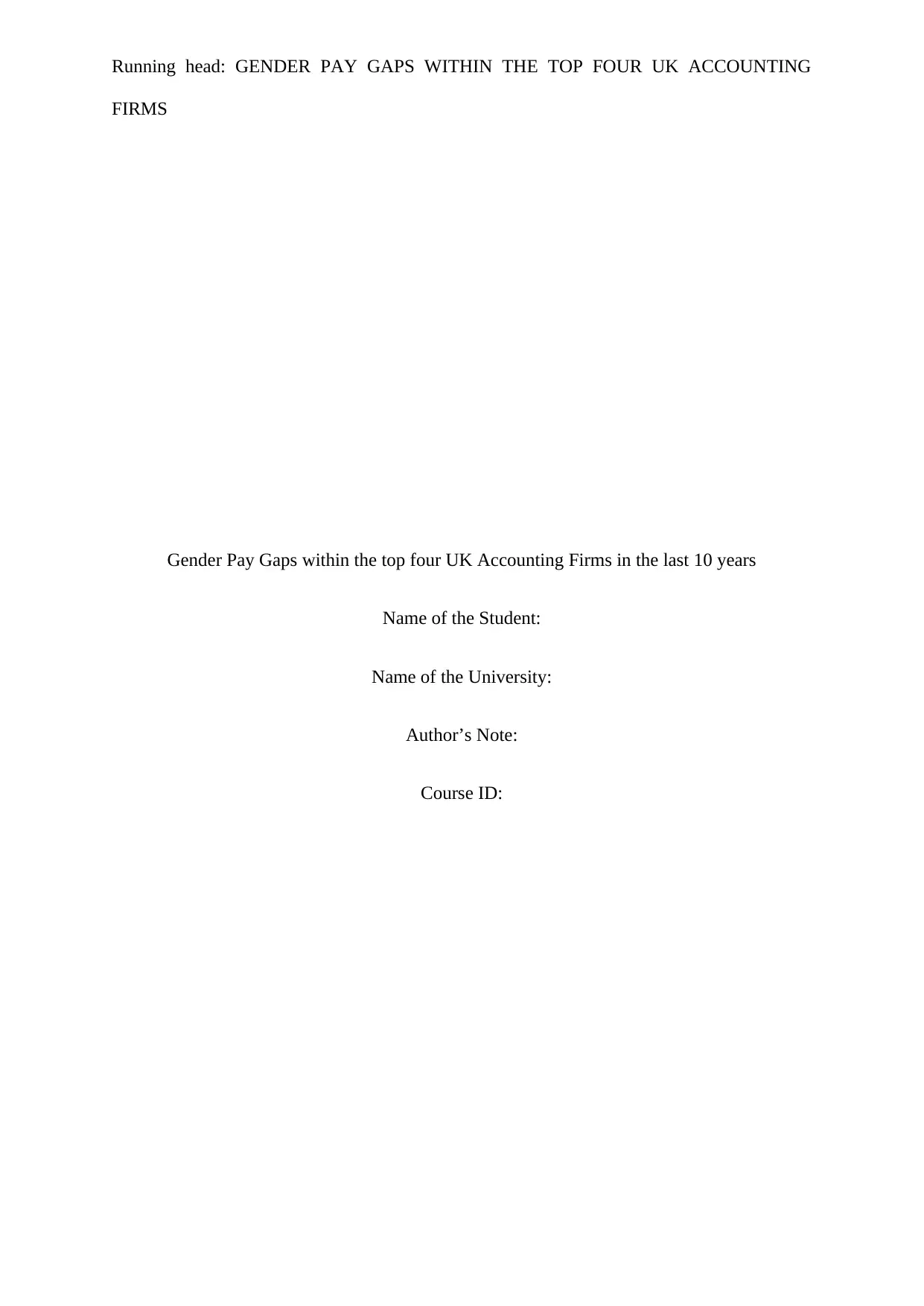
Running head: GENDER PAY GAPS WITHIN THE TOP FOUR UK ACCOUNTING
FIRMS
Gender Pay Gaps within the top four UK Accounting Firms in the last 10 years
Name of the Student:
Name of the University:
Author’s Note:
Course ID:
FIRMS
Gender Pay Gaps within the top four UK Accounting Firms in the last 10 years
Name of the Student:
Name of the University:
Author’s Note:
Course ID:
Paraphrase This Document
Need a fresh take? Get an instant paraphrase of this document with our AI Paraphraser
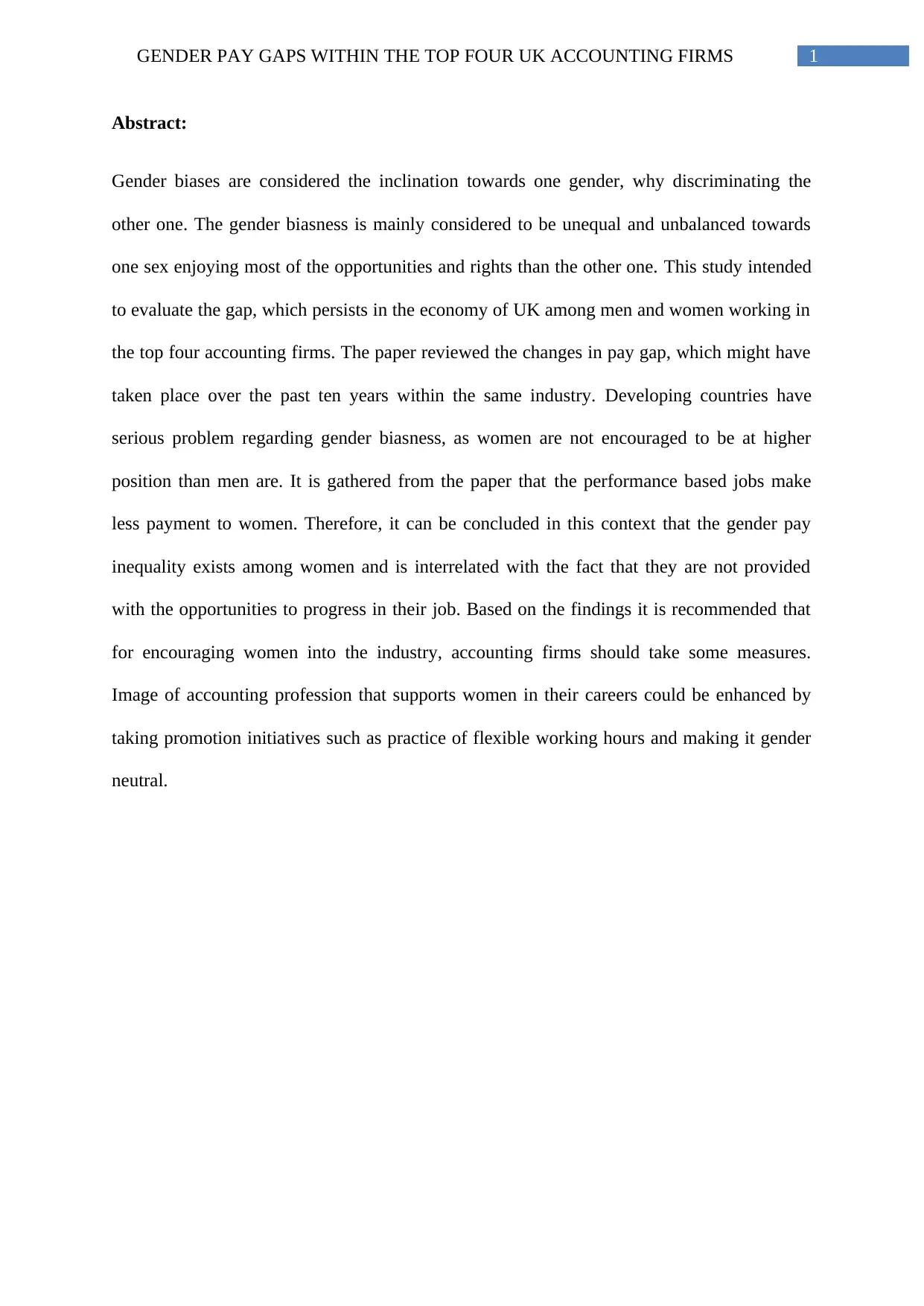
1GENDER PAY GAPS WITHIN THE TOP FOUR UK ACCOUNTING FIRMS
Abstract:
Gender biases are considered the inclination towards one gender, why discriminating the
other one. The gender biasness is mainly considered to be unequal and unbalanced towards
one sex enjoying most of the opportunities and rights than the other one. This study intended
to evaluate the gap, which persists in the economy of UK among men and women working in
the top four accounting firms. The paper reviewed the changes in pay gap, which might have
taken place over the past ten years within the same industry. Developing countries have
serious problem regarding gender biasness, as women are not encouraged to be at higher
position than men are. It is gathered from the paper that the performance based jobs make
less payment to women. Therefore, it can be concluded in this context that the gender pay
inequality exists among women and is interrelated with the fact that they are not provided
with the opportunities to progress in their job. Based on the findings it is recommended that
for encouraging women into the industry, accounting firms should take some measures.
Image of accounting profession that supports women in their careers could be enhanced by
taking promotion initiatives such as practice of flexible working hours and making it gender
neutral.
Abstract:
Gender biases are considered the inclination towards one gender, why discriminating the
other one. The gender biasness is mainly considered to be unequal and unbalanced towards
one sex enjoying most of the opportunities and rights than the other one. This study intended
to evaluate the gap, which persists in the economy of UK among men and women working in
the top four accounting firms. The paper reviewed the changes in pay gap, which might have
taken place over the past ten years within the same industry. Developing countries have
serious problem regarding gender biasness, as women are not encouraged to be at higher
position than men are. It is gathered from the paper that the performance based jobs make
less payment to women. Therefore, it can be concluded in this context that the gender pay
inequality exists among women and is interrelated with the fact that they are not provided
with the opportunities to progress in their job. Based on the findings it is recommended that
for encouraging women into the industry, accounting firms should take some measures.
Image of accounting profession that supports women in their careers could be enhanced by
taking promotion initiatives such as practice of flexible working hours and making it gender
neutral.
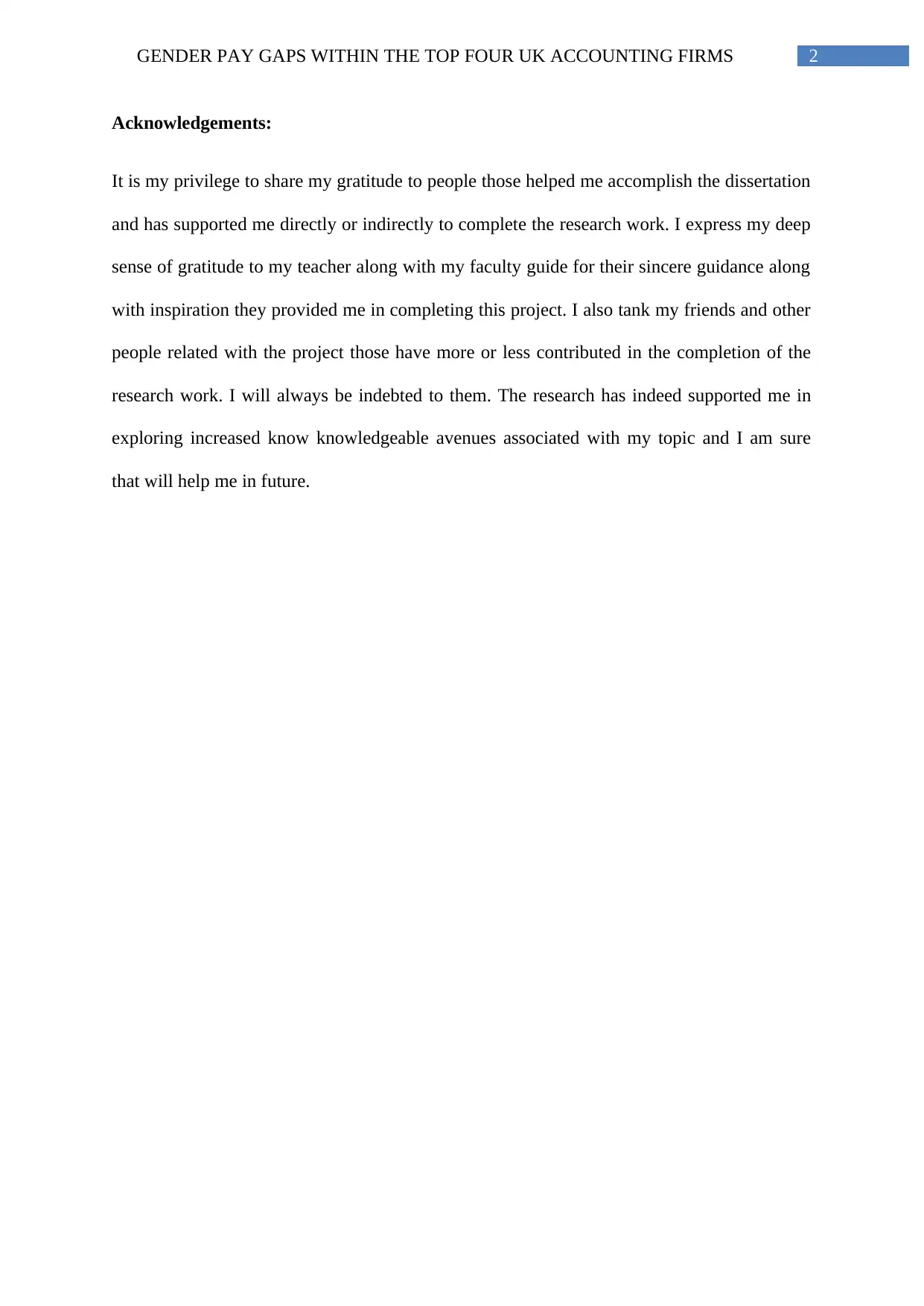
2GENDER PAY GAPS WITHIN THE TOP FOUR UK ACCOUNTING FIRMS
Acknowledgements:
It is my privilege to share my gratitude to people those helped me accomplish the dissertation
and has supported me directly or indirectly to complete the research work. I express my deep
sense of gratitude to my teacher along with my faculty guide for their sincere guidance along
with inspiration they provided me in completing this project. I also tank my friends and other
people related with the project those have more or less contributed in the completion of the
research work. I will always be indebted to them. The research has indeed supported me in
exploring increased know knowledgeable avenues associated with my topic and I am sure
that will help me in future.
Acknowledgements:
It is my privilege to share my gratitude to people those helped me accomplish the dissertation
and has supported me directly or indirectly to complete the research work. I express my deep
sense of gratitude to my teacher along with my faculty guide for their sincere guidance along
with inspiration they provided me in completing this project. I also tank my friends and other
people related with the project those have more or less contributed in the completion of the
research work. I will always be indebted to them. The research has indeed supported me in
exploring increased know knowledgeable avenues associated with my topic and I am sure
that will help me in future.
⊘ This is a preview!⊘
Do you want full access?
Subscribe today to unlock all pages.

Trusted by 1+ million students worldwide
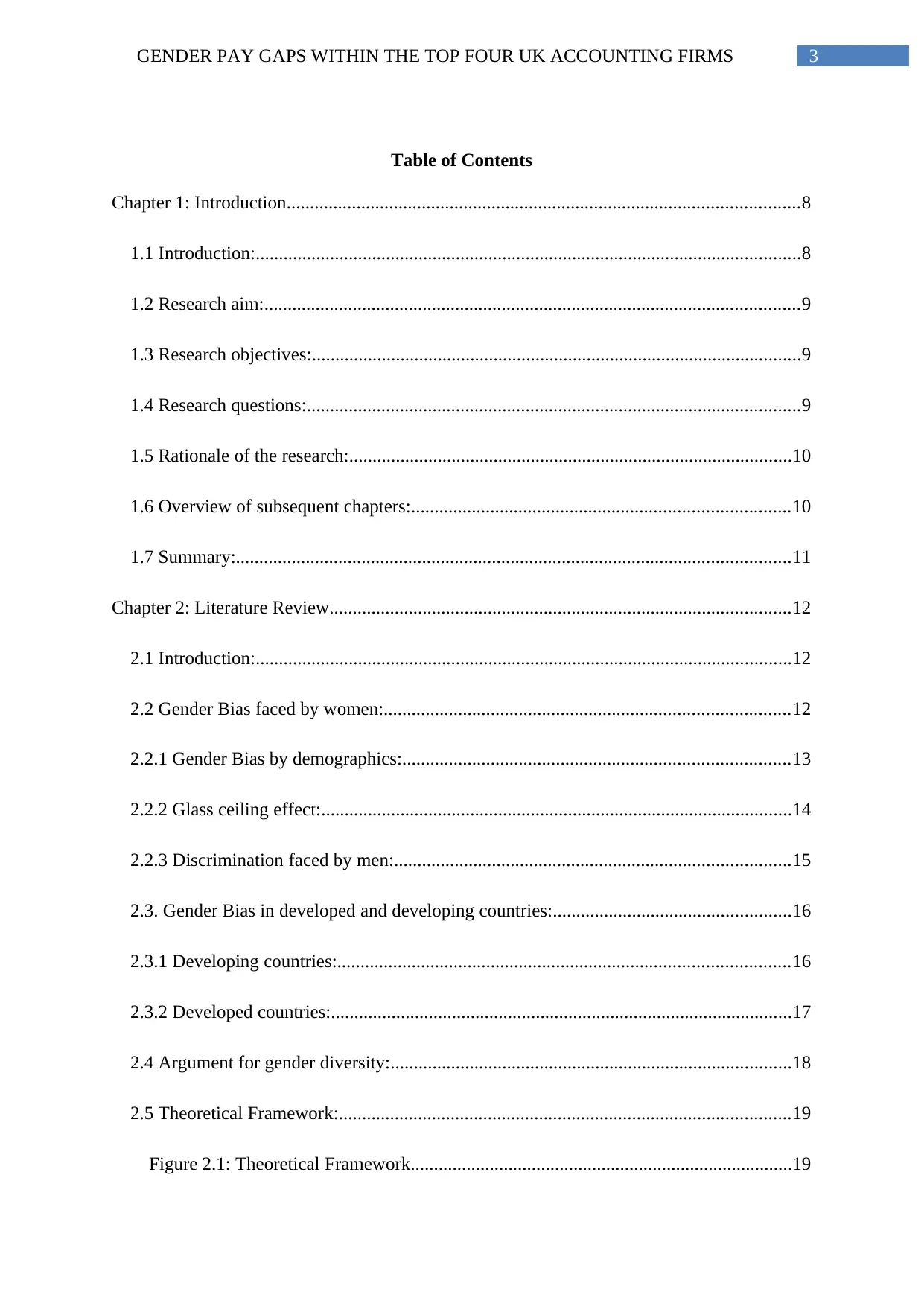
3GENDER PAY GAPS WITHIN THE TOP FOUR UK ACCOUNTING FIRMS
Table of Contents
Chapter 1: Introduction..............................................................................................................8
1.1 Introduction:.....................................................................................................................8
1.2 Research aim:...................................................................................................................9
1.3 Research objectives:.........................................................................................................9
1.4 Research questions:..........................................................................................................9
1.5 Rationale of the research:...............................................................................................10
1.6 Overview of subsequent chapters:.................................................................................10
1.7 Summary:.......................................................................................................................11
Chapter 2: Literature Review...................................................................................................12
2.1 Introduction:...................................................................................................................12
2.2 Gender Bias faced by women:.......................................................................................12
2.2.1 Gender Bias by demographics:...................................................................................13
2.2.2 Glass ceiling effect:.....................................................................................................14
2.2.3 Discrimination faced by men:.....................................................................................15
2.3. Gender Bias in developed and developing countries:...................................................16
2.3.1 Developing countries:.................................................................................................16
2.3.2 Developed countries:...................................................................................................17
2.4 Argument for gender diversity:......................................................................................18
2.5 Theoretical Framework:.................................................................................................19
Figure 2.1: Theoretical Framework..................................................................................19
Table of Contents
Chapter 1: Introduction..............................................................................................................8
1.1 Introduction:.....................................................................................................................8
1.2 Research aim:...................................................................................................................9
1.3 Research objectives:.........................................................................................................9
1.4 Research questions:..........................................................................................................9
1.5 Rationale of the research:...............................................................................................10
1.6 Overview of subsequent chapters:.................................................................................10
1.7 Summary:.......................................................................................................................11
Chapter 2: Literature Review...................................................................................................12
2.1 Introduction:...................................................................................................................12
2.2 Gender Bias faced by women:.......................................................................................12
2.2.1 Gender Bias by demographics:...................................................................................13
2.2.2 Glass ceiling effect:.....................................................................................................14
2.2.3 Discrimination faced by men:.....................................................................................15
2.3. Gender Bias in developed and developing countries:...................................................16
2.3.1 Developing countries:.................................................................................................16
2.3.2 Developed countries:...................................................................................................17
2.4 Argument for gender diversity:......................................................................................18
2.5 Theoretical Framework:.................................................................................................19
Figure 2.1: Theoretical Framework..................................................................................19
Paraphrase This Document
Need a fresh take? Get an instant paraphrase of this document with our AI Paraphraser
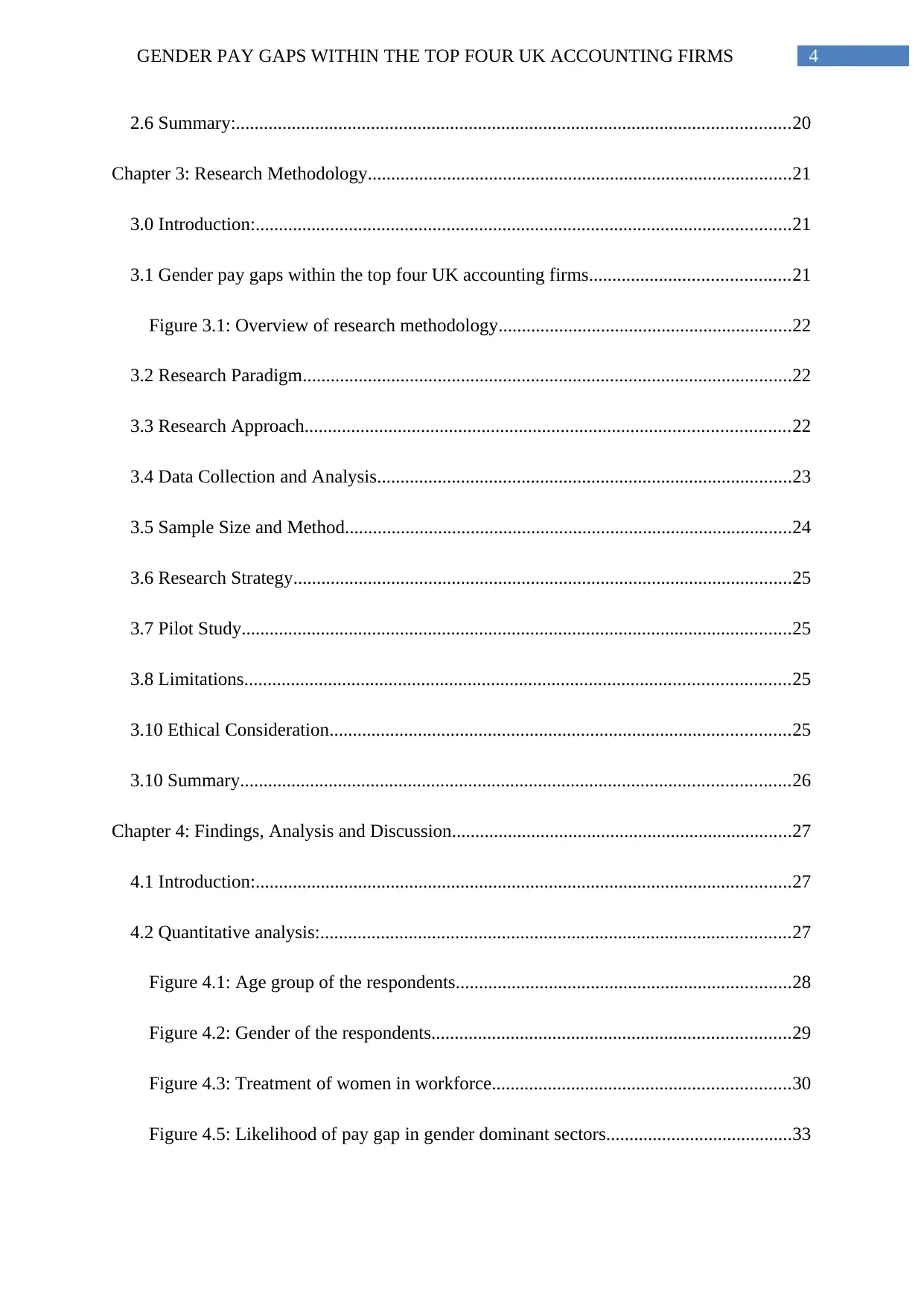
4GENDER PAY GAPS WITHIN THE TOP FOUR UK ACCOUNTING FIRMS
2.6 Summary:.......................................................................................................................20
Chapter 3: Research Methodology...........................................................................................21
3.0 Introduction:...................................................................................................................21
3.1 Gender pay gaps within the top four UK accounting firms...........................................21
Figure 3.1: Overview of research methodology...............................................................22
3.2 Research Paradigm.........................................................................................................22
3.3 Research Approach........................................................................................................22
3.4 Data Collection and Analysis.........................................................................................23
3.5 Sample Size and Method................................................................................................24
3.6 Research Strategy...........................................................................................................25
3.7 Pilot Study......................................................................................................................25
3.8 Limitations.....................................................................................................................25
3.10 Ethical Consideration...................................................................................................25
3.10 Summary......................................................................................................................26
Chapter 4: Findings, Analysis and Discussion.........................................................................27
4.1 Introduction:...................................................................................................................27
4.2 Quantitative analysis:.....................................................................................................27
Figure 4.1: Age group of the respondents........................................................................28
Figure 4.2: Gender of the respondents.............................................................................29
Figure 4.3: Treatment of women in workforce................................................................30
Figure 4.5: Likelihood of pay gap in gender dominant sectors........................................33
2.6 Summary:.......................................................................................................................20
Chapter 3: Research Methodology...........................................................................................21
3.0 Introduction:...................................................................................................................21
3.1 Gender pay gaps within the top four UK accounting firms...........................................21
Figure 3.1: Overview of research methodology...............................................................22
3.2 Research Paradigm.........................................................................................................22
3.3 Research Approach........................................................................................................22
3.4 Data Collection and Analysis.........................................................................................23
3.5 Sample Size and Method................................................................................................24
3.6 Research Strategy...........................................................................................................25
3.7 Pilot Study......................................................................................................................25
3.8 Limitations.....................................................................................................................25
3.10 Ethical Consideration...................................................................................................25
3.10 Summary......................................................................................................................26
Chapter 4: Findings, Analysis and Discussion.........................................................................27
4.1 Introduction:...................................................................................................................27
4.2 Quantitative analysis:.....................................................................................................27
Figure 4.1: Age group of the respondents........................................................................28
Figure 4.2: Gender of the respondents.............................................................................29
Figure 4.3: Treatment of women in workforce................................................................30
Figure 4.5: Likelihood of pay gap in gender dominant sectors........................................33
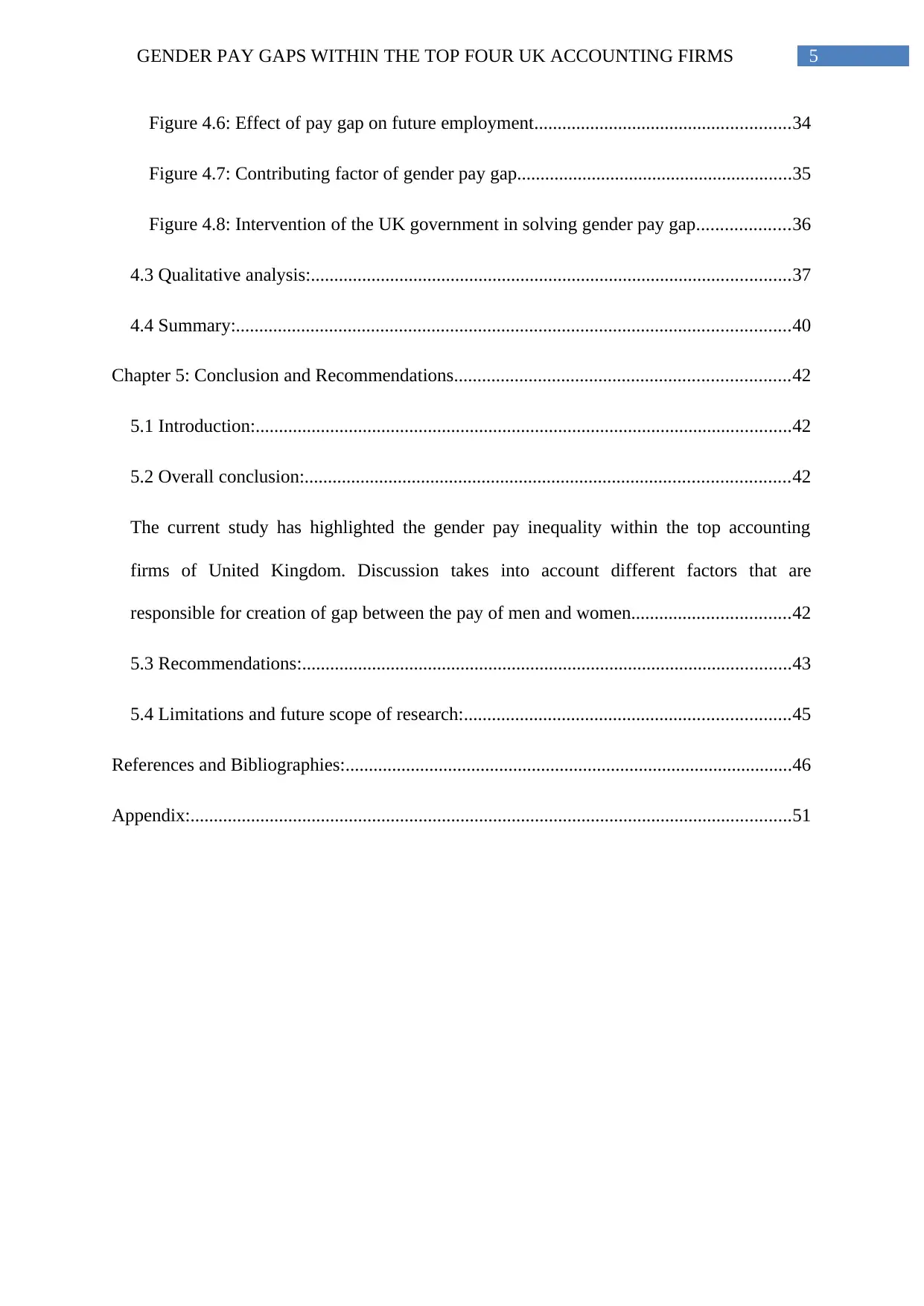
5GENDER PAY GAPS WITHIN THE TOP FOUR UK ACCOUNTING FIRMS
Figure 4.6: Effect of pay gap on future employment.......................................................34
Figure 4.7: Contributing factor of gender pay gap...........................................................35
Figure 4.8: Intervention of the UK government in solving gender pay gap....................36
4.3 Qualitative analysis:.......................................................................................................37
4.4 Summary:.......................................................................................................................40
Chapter 5: Conclusion and Recommendations........................................................................42
5.1 Introduction:...................................................................................................................42
5.2 Overall conclusion:........................................................................................................42
The current study has highlighted the gender pay inequality within the top accounting
firms of United Kingdom. Discussion takes into account different factors that are
responsible for creation of gap between the pay of men and women..................................42
5.3 Recommendations:.........................................................................................................43
5.4 Limitations and future scope of research:......................................................................45
References and Bibliographies:................................................................................................46
Appendix:.................................................................................................................................51
Figure 4.6: Effect of pay gap on future employment.......................................................34
Figure 4.7: Contributing factor of gender pay gap...........................................................35
Figure 4.8: Intervention of the UK government in solving gender pay gap....................36
4.3 Qualitative analysis:.......................................................................................................37
4.4 Summary:.......................................................................................................................40
Chapter 5: Conclusion and Recommendations........................................................................42
5.1 Introduction:...................................................................................................................42
5.2 Overall conclusion:........................................................................................................42
The current study has highlighted the gender pay inequality within the top accounting
firms of United Kingdom. Discussion takes into account different factors that are
responsible for creation of gap between the pay of men and women..................................42
5.3 Recommendations:.........................................................................................................43
5.4 Limitations and future scope of research:......................................................................45
References and Bibliographies:................................................................................................46
Appendix:.................................................................................................................................51
⊘ This is a preview!⊘
Do you want full access?
Subscribe today to unlock all pages.

Trusted by 1+ million students worldwide
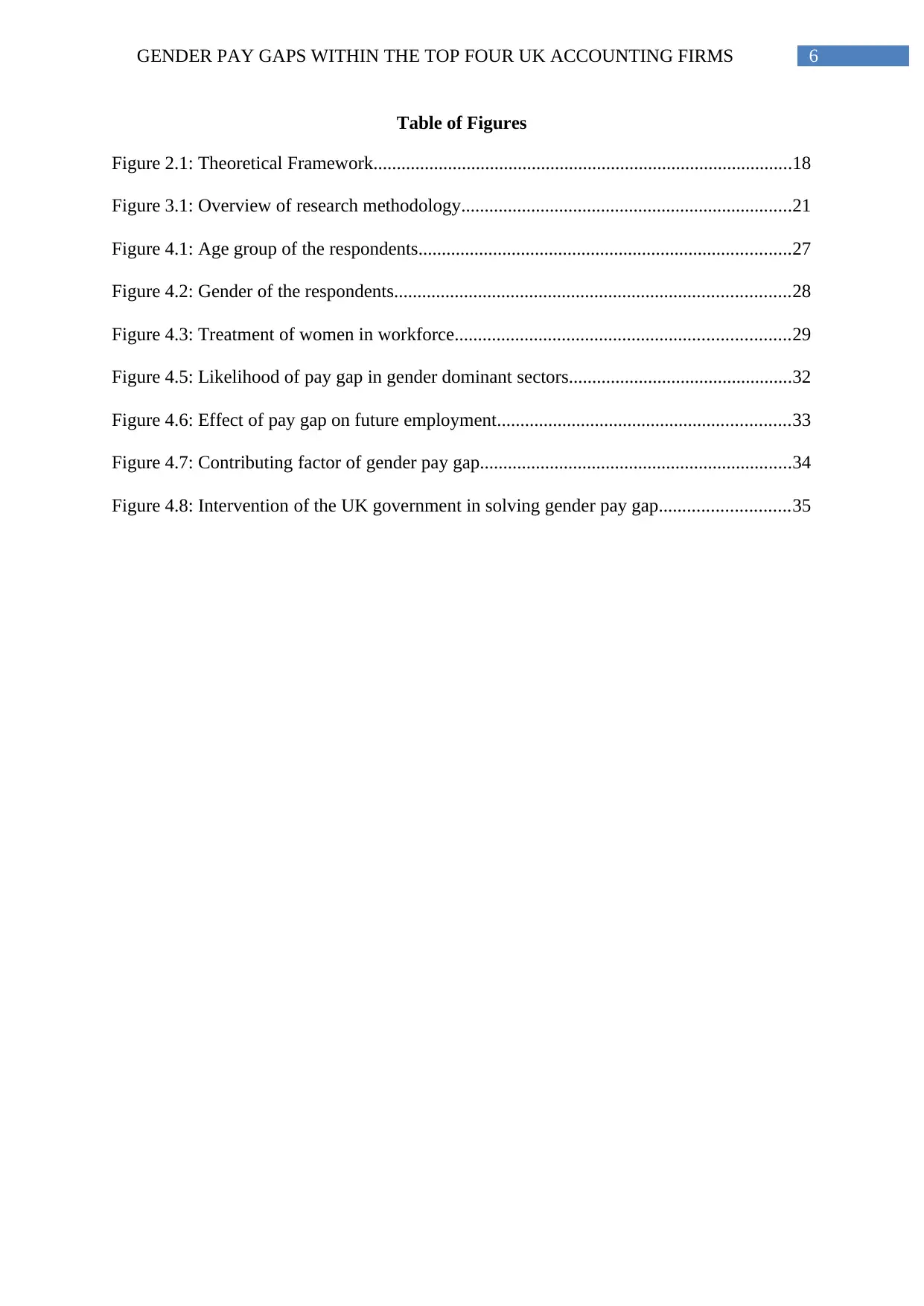
6GENDER PAY GAPS WITHIN THE TOP FOUR UK ACCOUNTING FIRMS
Table of Figures
Figure 2.1: Theoretical Framework..........................................................................................18
Figure 3.1: Overview of research methodology.......................................................................21
Figure 4.1: Age group of the respondents................................................................................27
Figure 4.2: Gender of the respondents.....................................................................................28
Figure 4.3: Treatment of women in workforce........................................................................29
Figure 4.5: Likelihood of pay gap in gender dominant sectors................................................32
Figure 4.6: Effect of pay gap on future employment...............................................................33
Figure 4.7: Contributing factor of gender pay gap...................................................................34
Figure 4.8: Intervention of the UK government in solving gender pay gap............................35
Table of Figures
Figure 2.1: Theoretical Framework..........................................................................................18
Figure 3.1: Overview of research methodology.......................................................................21
Figure 4.1: Age group of the respondents................................................................................27
Figure 4.2: Gender of the respondents.....................................................................................28
Figure 4.3: Treatment of women in workforce........................................................................29
Figure 4.5: Likelihood of pay gap in gender dominant sectors................................................32
Figure 4.6: Effect of pay gap on future employment...............................................................33
Figure 4.7: Contributing factor of gender pay gap...................................................................34
Figure 4.8: Intervention of the UK government in solving gender pay gap............................35
Paraphrase This Document
Need a fresh take? Get an instant paraphrase of this document with our AI Paraphraser
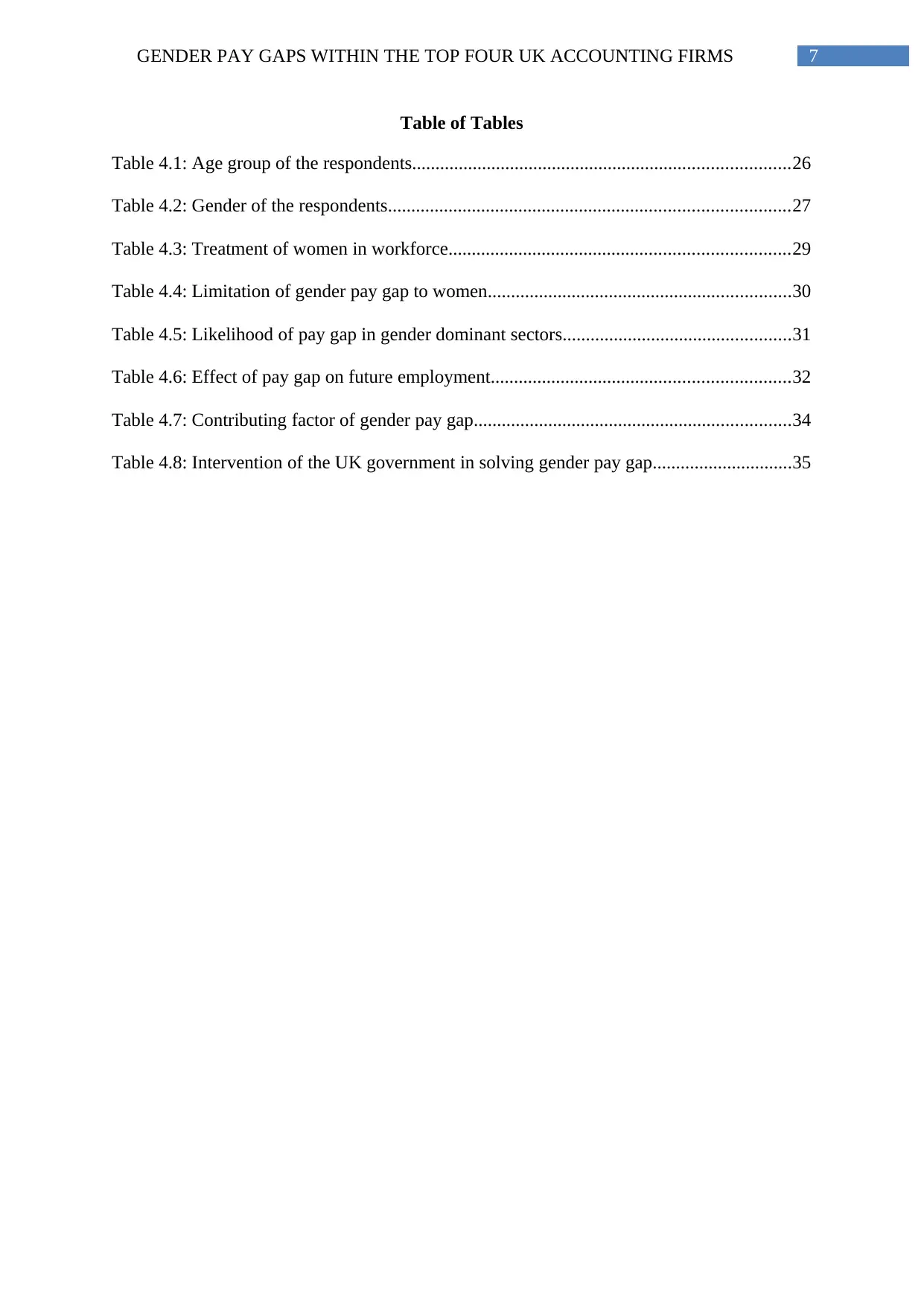
7GENDER PAY GAPS WITHIN THE TOP FOUR UK ACCOUNTING FIRMS
Table of Tables
Table 4.1: Age group of the respondents.................................................................................26
Table 4.2: Gender of the respondents......................................................................................27
Table 4.3: Treatment of women in workforce.........................................................................29
Table 4.4: Limitation of gender pay gap to women.................................................................30
Table 4.5: Likelihood of pay gap in gender dominant sectors.................................................31
Table 4.6: Effect of pay gap on future employment................................................................32
Table 4.7: Contributing factor of gender pay gap....................................................................34
Table 4.8: Intervention of the UK government in solving gender pay gap..............................35
Table of Tables
Table 4.1: Age group of the respondents.................................................................................26
Table 4.2: Gender of the respondents......................................................................................27
Table 4.3: Treatment of women in workforce.........................................................................29
Table 4.4: Limitation of gender pay gap to women.................................................................30
Table 4.5: Likelihood of pay gap in gender dominant sectors.................................................31
Table 4.6: Effect of pay gap on future employment................................................................32
Table 4.7: Contributing factor of gender pay gap....................................................................34
Table 4.8: Intervention of the UK government in solving gender pay gap..............................35
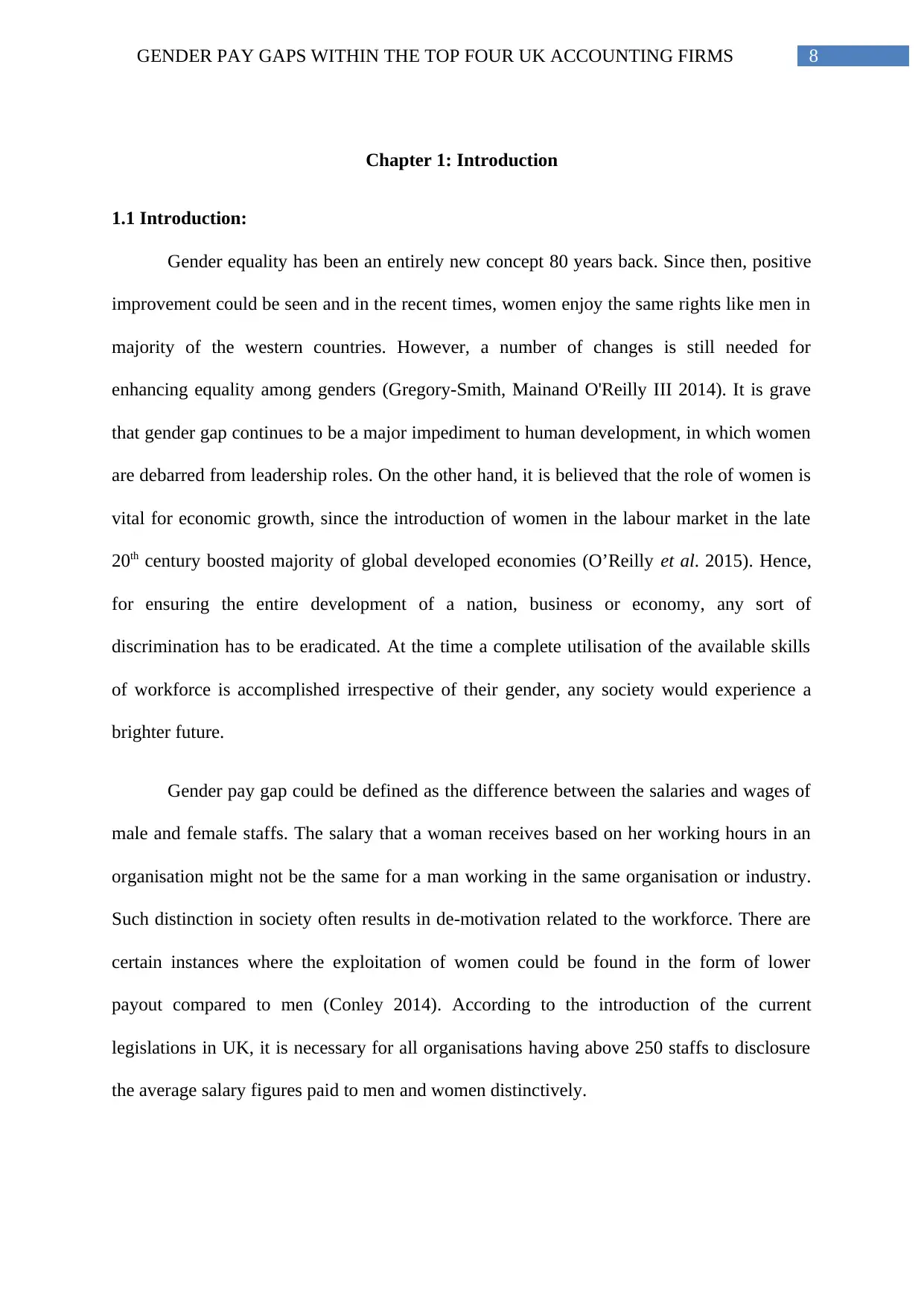
8GENDER PAY GAPS WITHIN THE TOP FOUR UK ACCOUNTING FIRMS
Chapter 1: Introduction
1.1 Introduction:
Gender equality has been an entirely new concept 80 years back. Since then, positive
improvement could be seen and in the recent times, women enjoy the same rights like men in
majority of the western countries. However, a number of changes is still needed for
enhancing equality among genders (Gregory‐Smith, Mainand O'Reilly III 2014). It is grave
that gender gap continues to be a major impediment to human development, in which women
are debarred from leadership roles. On the other hand, it is believed that the role of women is
vital for economic growth, since the introduction of women in the labour market in the late
20th century boosted majority of global developed economies (O’Reilly et al. 2015). Hence,
for ensuring the entire development of a nation, business or economy, any sort of
discrimination has to be eradicated. At the time a complete utilisation of the available skills
of workforce is accomplished irrespective of their gender, any society would experience a
brighter future.
Gender pay gap could be defined as the difference between the salaries and wages of
male and female staffs. The salary that a woman receives based on her working hours in an
organisation might not be the same for a man working in the same organisation or industry.
Such distinction in society often results in de-motivation related to the workforce. There are
certain instances where the exploitation of women could be found in the form of lower
payout compared to men (Conley 2014). According to the introduction of the current
legislations in UK, it is necessary for all organisations having above 250 staffs to disclosure
the average salary figures paid to men and women distinctively.
Chapter 1: Introduction
1.1 Introduction:
Gender equality has been an entirely new concept 80 years back. Since then, positive
improvement could be seen and in the recent times, women enjoy the same rights like men in
majority of the western countries. However, a number of changes is still needed for
enhancing equality among genders (Gregory‐Smith, Mainand O'Reilly III 2014). It is grave
that gender gap continues to be a major impediment to human development, in which women
are debarred from leadership roles. On the other hand, it is believed that the role of women is
vital for economic growth, since the introduction of women in the labour market in the late
20th century boosted majority of global developed economies (O’Reilly et al. 2015). Hence,
for ensuring the entire development of a nation, business or economy, any sort of
discrimination has to be eradicated. At the time a complete utilisation of the available skills
of workforce is accomplished irrespective of their gender, any society would experience a
brighter future.
Gender pay gap could be defined as the difference between the salaries and wages of
male and female staffs. The salary that a woman receives based on her working hours in an
organisation might not be the same for a man working in the same organisation or industry.
Such distinction in society often results in de-motivation related to the workforce. There are
certain instances where the exploitation of women could be found in the form of lower
payout compared to men (Conley 2014). According to the introduction of the current
legislations in UK, it is necessary for all organisations having above 250 staffs to disclosure
the average salary figures paid to men and women distinctively.
⊘ This is a preview!⊘
Do you want full access?
Subscribe today to unlock all pages.

Trusted by 1+ million students worldwide
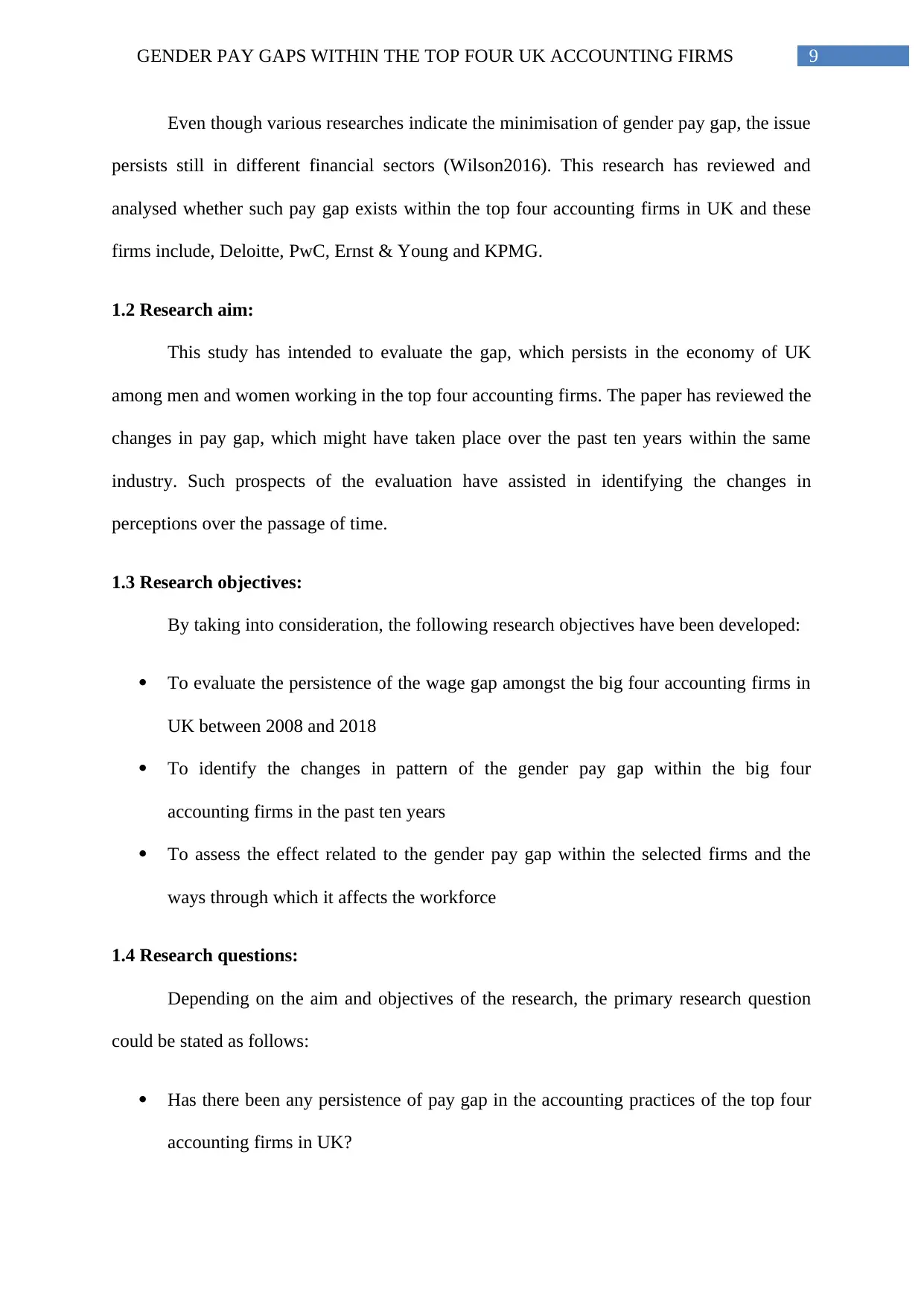
9GENDER PAY GAPS WITHIN THE TOP FOUR UK ACCOUNTING FIRMS
Even though various researches indicate the minimisation of gender pay gap, the issue
persists still in different financial sectors (Wilson2016). This research has reviewed and
analysed whether such pay gap exists within the top four accounting firms in UK and these
firms include, Deloitte, PwC, Ernst & Young and KPMG.
1.2 Research aim:
This study has intended to evaluate the gap, which persists in the economy of UK
among men and women working in the top four accounting firms. The paper has reviewed the
changes in pay gap, which might have taken place over the past ten years within the same
industry. Such prospects of the evaluation have assisted in identifying the changes in
perceptions over the passage of time.
1.3 Research objectives:
By taking into consideration, the following research objectives have been developed:
To evaluate the persistence of the wage gap amongst the big four accounting firms in
UK between 2008 and 2018
To identify the changes in pattern of the gender pay gap within the big four
accounting firms in the past ten years
To assess the effect related to the gender pay gap within the selected firms and the
ways through which it affects the workforce
1.4 Research questions:
Depending on the aim and objectives of the research, the primary research question
could be stated as follows:
Has there been any persistence of pay gap in the accounting practices of the top four
accounting firms in UK?
Even though various researches indicate the minimisation of gender pay gap, the issue
persists still in different financial sectors (Wilson2016). This research has reviewed and
analysed whether such pay gap exists within the top four accounting firms in UK and these
firms include, Deloitte, PwC, Ernst & Young and KPMG.
1.2 Research aim:
This study has intended to evaluate the gap, which persists in the economy of UK
among men and women working in the top four accounting firms. The paper has reviewed the
changes in pay gap, which might have taken place over the past ten years within the same
industry. Such prospects of the evaluation have assisted in identifying the changes in
perceptions over the passage of time.
1.3 Research objectives:
By taking into consideration, the following research objectives have been developed:
To evaluate the persistence of the wage gap amongst the big four accounting firms in
UK between 2008 and 2018
To identify the changes in pattern of the gender pay gap within the big four
accounting firms in the past ten years
To assess the effect related to the gender pay gap within the selected firms and the
ways through which it affects the workforce
1.4 Research questions:
Depending on the aim and objectives of the research, the primary research question
could be stated as follows:
Has there been any persistence of pay gap in the accounting practices of the top four
accounting firms in UK?
Paraphrase This Document
Need a fresh take? Get an instant paraphrase of this document with our AI Paraphraser
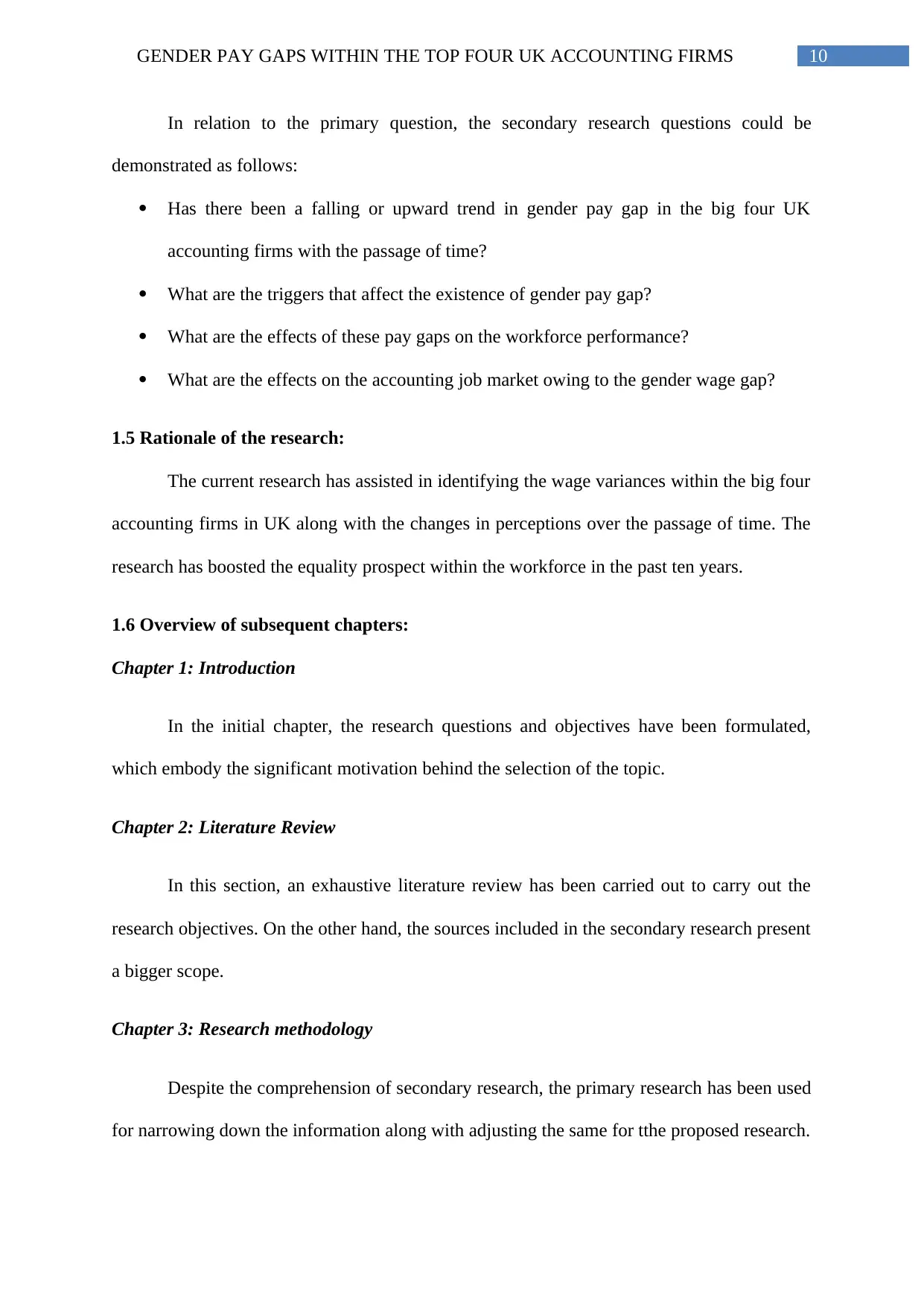
10GENDER PAY GAPS WITHIN THE TOP FOUR UK ACCOUNTING FIRMS
In relation to the primary question, the secondary research questions could be
demonstrated as follows:
Has there been a falling or upward trend in gender pay gap in the big four UK
accounting firms with the passage of time?
What are the triggers that affect the existence of gender pay gap?
What are the effects of these pay gaps on the workforce performance?
What are the effects on the accounting job market owing to the gender wage gap?
1.5 Rationale of the research:
The current research has assisted in identifying the wage variances within the big four
accounting firms in UK along with the changes in perceptions over the passage of time. The
research has boosted the equality prospect within the workforce in the past ten years.
1.6 Overview of subsequent chapters:
Chapter 1: Introduction
In the initial chapter, the research questions and objectives have been formulated,
which embody the significant motivation behind the selection of the topic.
Chapter 2: Literature Review
In this section, an exhaustive literature review has been carried out to carry out the
research objectives. On the other hand, the sources included in the secondary research present
a bigger scope.
Chapter 3: Research methodology
Despite the comprehension of secondary research, the primary research has been used
for narrowing down the information along with adjusting the same for tthe proposed research.
In relation to the primary question, the secondary research questions could be
demonstrated as follows:
Has there been a falling or upward trend in gender pay gap in the big four UK
accounting firms with the passage of time?
What are the triggers that affect the existence of gender pay gap?
What are the effects of these pay gaps on the workforce performance?
What are the effects on the accounting job market owing to the gender wage gap?
1.5 Rationale of the research:
The current research has assisted in identifying the wage variances within the big four
accounting firms in UK along with the changes in perceptions over the passage of time. The
research has boosted the equality prospect within the workforce in the past ten years.
1.6 Overview of subsequent chapters:
Chapter 1: Introduction
In the initial chapter, the research questions and objectives have been formulated,
which embody the significant motivation behind the selection of the topic.
Chapter 2: Literature Review
In this section, an exhaustive literature review has been carried out to carry out the
research objectives. On the other hand, the sources included in the secondary research present
a bigger scope.
Chapter 3: Research methodology
Despite the comprehension of secondary research, the primary research has been used
for narrowing down the information along with adjusting the same for tthe proposed research.
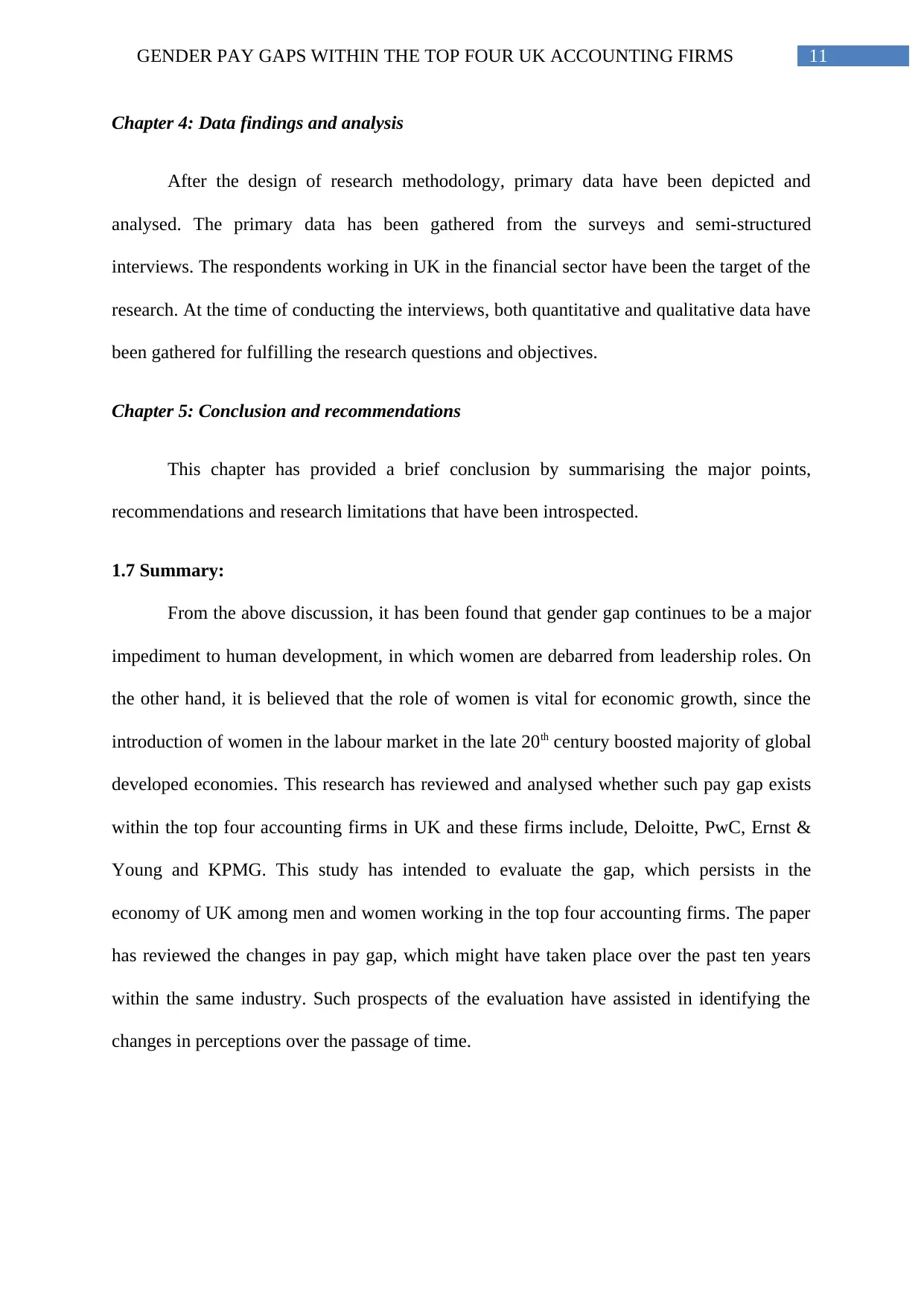
11GENDER PAY GAPS WITHIN THE TOP FOUR UK ACCOUNTING FIRMS
Chapter 4: Data findings and analysis
After the design of research methodology, primary data have been depicted and
analysed. The primary data has been gathered from the surveys and semi-structured
interviews. The respondents working in UK in the financial sector have been the target of the
research. At the time of conducting the interviews, both quantitative and qualitative data have
been gathered for fulfilling the research questions and objectives.
Chapter 5: Conclusion and recommendations
This chapter has provided a brief conclusion by summarising the major points,
recommendations and research limitations that have been introspected.
1.7 Summary:
From the above discussion, it has been found that gender gap continues to be a major
impediment to human development, in which women are debarred from leadership roles. On
the other hand, it is believed that the role of women is vital for economic growth, since the
introduction of women in the labour market in the late 20th century boosted majority of global
developed economies. This research has reviewed and analysed whether such pay gap exists
within the top four accounting firms in UK and these firms include, Deloitte, PwC, Ernst &
Young and KPMG. This study has intended to evaluate the gap, which persists in the
economy of UK among men and women working in the top four accounting firms. The paper
has reviewed the changes in pay gap, which might have taken place over the past ten years
within the same industry. Such prospects of the evaluation have assisted in identifying the
changes in perceptions over the passage of time.
Chapter 4: Data findings and analysis
After the design of research methodology, primary data have been depicted and
analysed. The primary data has been gathered from the surveys and semi-structured
interviews. The respondents working in UK in the financial sector have been the target of the
research. At the time of conducting the interviews, both quantitative and qualitative data have
been gathered for fulfilling the research questions and objectives.
Chapter 5: Conclusion and recommendations
This chapter has provided a brief conclusion by summarising the major points,
recommendations and research limitations that have been introspected.
1.7 Summary:
From the above discussion, it has been found that gender gap continues to be a major
impediment to human development, in which women are debarred from leadership roles. On
the other hand, it is believed that the role of women is vital for economic growth, since the
introduction of women in the labour market in the late 20th century boosted majority of global
developed economies. This research has reviewed and analysed whether such pay gap exists
within the top four accounting firms in UK and these firms include, Deloitte, PwC, Ernst &
Young and KPMG. This study has intended to evaluate the gap, which persists in the
economy of UK among men and women working in the top four accounting firms. The paper
has reviewed the changes in pay gap, which might have taken place over the past ten years
within the same industry. Such prospects of the evaluation have assisted in identifying the
changes in perceptions over the passage of time.
⊘ This is a preview!⊘
Do you want full access?
Subscribe today to unlock all pages.

Trusted by 1+ million students worldwide
1 out of 54
Related Documents
Your All-in-One AI-Powered Toolkit for Academic Success.
+13062052269
info@desklib.com
Available 24*7 on WhatsApp / Email
![[object Object]](/_next/static/media/star-bottom.7253800d.svg)
Unlock your academic potential
Copyright © 2020–2025 A2Z Services. All Rights Reserved. Developed and managed by ZUCOL.





